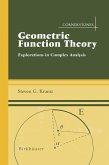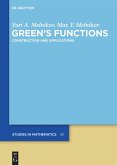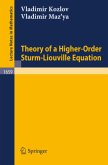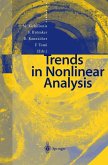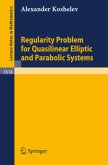* Examines a nonlinear system of parabolic PDEs arising in mathematical biology and statistical mechanics * Describes the whole picture, i.e., the mathematical and physical principles * Suitable for researchers and grad students in mathematics and applied mathematics who are interested in nonlinear PDEs in stochastic processes, cellular automatons, variational methods, and their applications to physics, chemistry, biology, and engineering
This book examines a system of parabolic-elliptic partial differential eq- tions proposed in mathematical biology, statistical mechanics, and chemical kinetics. In the context of biology, this system of equations describes the chemotactic feature of cellular slime molds and also the capillary formation of blood vessels in angiogenesis. There are several methods to derive this system. One is the biased random walk of the individual, and another is the reinforced random walk of one particle modelled on the cellular automaton. In the context of statistical mechanics or chemical kinetics, this system of equations describes the motion of a mean ?eld of many particles, interacting under the gravitational inner force or the chemical reaction, and therefore this system is af?liated with a hierarchy of equations: Langevin, Fokker-Planck, Liouville-Gel'fand, and the gradient ?ow. All of the equations are subject to the second law of thermodynamics - the decrease of free energy. The mat- matical principle of this hierarchy, on the other hand, is referred to as the qu- tized blowup mechanism; the blowup solution of our system develops delta function singularities with the quantized mass.
This book examines a system of parabolic-elliptic partial differential eq- tions proposed in mathematical biology, statistical mechanics, and chemical kinetics. In the context of biology, this system of equations describes the chemotactic feature of cellular slime molds and also the capillary formation of blood vessels in angiogenesis. There are several methods to derive this system. One is the biased random walk of the individual, and another is the reinforced random walk of one particle modelled on the cellular automaton. In the context of statistical mechanics or chemical kinetics, this system of equations describes the motion of a mean ?eld of many particles, interacting under the gravitational inner force or the chemical reaction, and therefore this system is af?liated with a hierarchy of equations: Langevin, Fokker-Planck, Liouville-Gel'fand, and the gradient ?ow. All of the equations are subject to the second law of thermodynamics - the decrease of free energy. The mat- matical principle of this hierarchy, on the other hand, is referred to as the qu- tized blowup mechanism; the blowup solution of our system develops delta function singularities with the quantized mass.
From the reviews:
"This book is primarily concerned with systems of partial differential equations of elliptic-parabolic type. Such systems are special cases of systems of pdes that occur naturally in biochemistry, biophysics, molecular biology, and in chemical thermodynamics and statistical mechanics-in short wherever chemical kinetics and diffusive processes are present in a system.... The book itself is well organized and readable although very technical. It is a book about the mathematics of systems and not biology or thermodynamics.... [It] certainly belongs on the bookshelf of specialists in nonlinear pde/math biology." -Bulletin of the AMS
"This book is introductory in the sense of being accessible to students not only of mathematics, but also of the physical and the engineering sciences once they have mastered the introductory mathematical courses. ...Overall, the presentation is quite detailed regarding the needs of the practitioner with many examples to engineering, earth sciences, etc. (among others elasticity, vibrations, heat transfer, fluid flow; also eigenvalue problems), and special but important items not so often covered in other texts, e.g., how to cope with the specific difficulties arising in polar coordinates. Both numerous exercises and codes in Ansys, Fortran, Mathematica® and MATLAB direct the reader towards experimentation of his own." (Monatshefte fur Mathematik)
"This book examines a nonlinear system of parabolic partial differential equations (PDEs) arising in mathematical biology and statistical mechanics. ... Free Energy and Self-Interacting Particles is suitable for researchers and graduate students of mathematics and applied mathematics who are interested in non-linear PDEs in stochastic processes, cellular automata, variational methods, and their applications to natural sciences. It is also suitable for researchers in other fields such as physics, chemistry, biology, andengineering." (Christopher Mayer, Simulation News Europe, Vol. 16 (1), 2006)
"This book is primarily concerned with systems of partial differential equations of elliptic-parabolic type. Such systems are special cases of systems of pdes that occur naturally in biochemistry, biophysics, molecular biology, and in chemical thermodynamics and statistical mechanics-in short wherever chemical kinetics and diffusive processes are present in a system.... The book itself is well organized and readable although very technical. It is a book about the mathematics of systems and not biology or thermodynamics.... [It] certainly belongs on the bookshelf of specialists in nonlinear pde/math biology." -Bulletin of the AMS
"This book is introductory in the sense of being accessible to students not only of mathematics, but also of the physical and the engineering sciences once they have mastered the introductory mathematical courses. ...Overall, the presentation is quite detailed regarding the needs of the practitioner with many examples to engineering, earth sciences, etc. (among others elasticity, vibrations, heat transfer, fluid flow; also eigenvalue problems), and special but important items not so often covered in other texts, e.g., how to cope with the specific difficulties arising in polar coordinates. Both numerous exercises and codes in Ansys, Fortran, Mathematica® and MATLAB direct the reader towards experimentation of his own." (Monatshefte fur Mathematik)
"This book examines a nonlinear system of parabolic partial differential equations (PDEs) arising in mathematical biology and statistical mechanics. ... Free Energy and Self-Interacting Particles is suitable for researchers and graduate students of mathematics and applied mathematics who are interested in non-linear PDEs in stochastic processes, cellular automata, variational methods, and their applications to natural sciences. It is also suitable for researchers in other fields such as physics, chemistry, biology, andengineering." (Christopher Mayer, Simulation News Europe, Vol. 16 (1), 2006)




